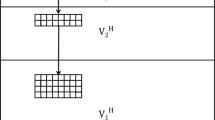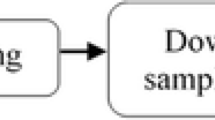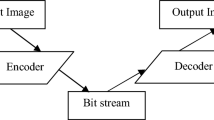Abstract
This paper presents a novel Multiresolution, Perceptual and Vector Quantization (MPVQ) based video coding scheme. In the intra-frame mode of operation, a wavelet transform is applied to the input frame and decorrelates it into its frequency subbands. The coefficients in each detail subband are pixel quantized using a uniform quantization factor divided by the perceptual weighting factor of that subband. The quantized coefficients are finally coded using a quadtree-coding algorithm. Perceptual weights are specifically calculated for the centre of each detail subband. In the inter-frame mode of operation, a Displaced Frame Difference (DFD) is first generated using an overlapped block motion estimation/compensation technique. A wavelet transform is then applied on the DFD and converts it into its frequency subbands. The detail subbands are finally vector quantized using an Adaptive Vector Quantization (AVQ) scheme. To evaluate the performance of the proposed codec, the proposed codec and the adaptive subband vector quantization coding scheme (ASVQ), which has been shown to outperform H.263 at all bitrates, were applied to six test sequences. Experimental results indicate that the proposed codec outperforms the ASVQ subjectively and objectively at all bit rates.





Similar content being viewed by others
References
Al-Hudhud G (2009) Adaptation of HVS sensitivity for perceptual modelling of wavelet-based image compression. International Conference in Visualisation, pp 196–200
Antonini M, Barlaud M, Mathieu P, Daubechies I (1992) Image coding using the wavelet transform. IEEE Trans Image Process 1(No. 2):205–220
Ashraf G, Chong MN (1997) Performance analysis of H.261 and H.263 video coding algorithms. IEEE International Symposium on Consumer Electronics ISCE ‘97, pp 153–156
Bradley AP (1999) A wavelet visible difference predictor. IEEE Trans Image Process, 8(no. 5)
Fraunhofer, Institut Nachrichtentechnik Heinrich-Hertz-Institute, H.264/AVC software version: JM 17.2. Available from: http://iphome.hhi.de/suehring/tml/ [accessed 16/11/2010]
Ghanbari M (1999) Video coding an introduction to standard codecs. The Institution of Electrical Engineering, London
HSontsch I, Karam LJ (2000) Locally adaptive perceptual image coding. IEEE Trans Image Process 9(9):1472–1483
Kaia X, Jiea Y, Minb ZY, Lianga LX (2005) HVS-based medical image compression. Eur J Radiol 55:139–145
Katto J, Ohki J, Nogaki S, Ohta M (1994) A wavelet codec with overlapped motion compensation for very low bit-rate environment. IEEE Trans Circuits Syst Video Technol 4(3):328–338
Lin M, Ngan KN (2010) Adaptive block-size transform based just-noticeable difference profile for videos. IEEE International Symposium on Circuits and Systems (ISCAS), pp 4213–4216
Maalouf A, Larabi M–C (2010) A no-reference color video quality metric based on a 3D multispectral wavelet transform. International Workshop on Quality of Multimedia Experience (QoMEX), pp 11–16
Murat Tekalp A (1995) Digital video processing. Prentice-Hall, ISBN: 0-13-190075-7
Nadenau MJ, Reichel J (2003) Wavelet-based color image compression: Exploiting the contrast sensitivity function. IEEE Trans Image Process, 12(no. 1), January
Ostermann J, Bormans J, List P, Marpe D, Narroschke M, Pereira F, Stockhammer T, Wedi T (2004) Video coding with H.264/AVC: Tools, performance, and complexity. IEEE Circuits Syst Mag 4:7–28
Pastuszak G (2005) A high-performance architecture for embedded block coding in JPEG 2000. IEEE Trans Circuit Syst Video Technol, 15(no. 9), September
Samet H (1984) The quadtree and related hierarchical data structures. ACM Comput Surv, 16(no. 2), June
Sheikh Akbari A, Soraghan JJ (2003) Adaptive joint subband vector quantisation codec for handheld videophone applications. IEE Electr Lett 39(no.14):1044–1046
Skodras A, Christopoulos Ch, Ebrahimi T (2001) The JPEG 2000 still image compression standard. IEEE Signal Process Mag, 18(no. 5), September
Taubman D (2000) High performance scalable image compression with EBCOT. IEEE Trans Image Process, 9(no. 7)
Taubman DS, Marcellin MW (2004) JPEG 2000 image compression fundamentals, standard and practice. Kluwer Academic Publisher, Massachusetts
Van Dyck RE, Rajala SA (1994) Subband/VQ coding of colour images with perceptually optimal bit allocation. IEEE Trans Circuit Syst Video Technol, 4(no. 1), February
Voukelatos SP, Soraghan JJ (1997) Very low bit rate color video coding using adaptive subband vector quantization with dynamic bit allocation. IEEE Trans Circuit Syst Video Technol 7(2):424–428
Yang X, Lin W, Lu Z (2005) Motion-compensated residue preprocessing in video coding based on just-noticeable-distortion profile. IEEE Trans Circuits Syst Video Technol, 15(no. 6), June
Author information
Authors and Affiliations
Corresponding author
Rights and permissions
About this article
Cite this article
Sheikh Akbari, A., Bagheri Zadeh, P., Buggy, T. et al. Multiresolution, perceptual and vector quantization based video codec. Multimed Tools Appl 58, 569–583 (2012). https://doi.org/10.1007/s11042-011-0752-y
Published:
Issue Date:
DOI: https://doi.org/10.1007/s11042-011-0752-y




